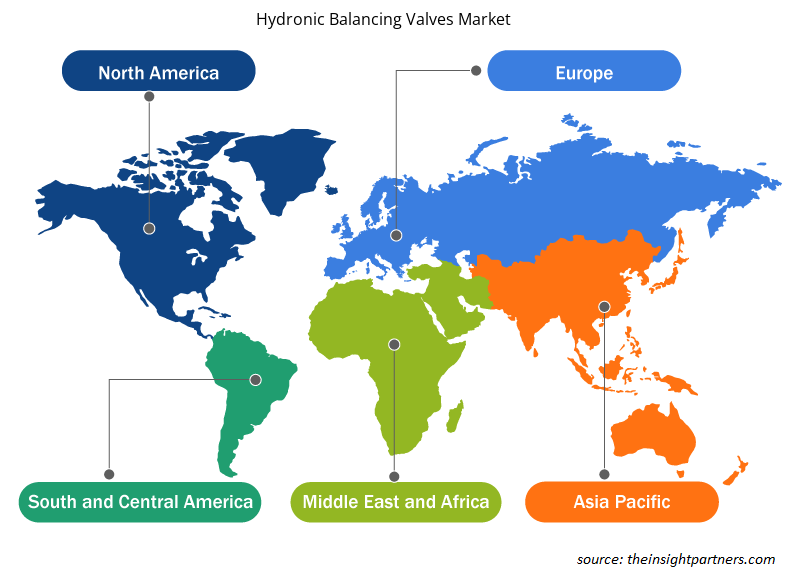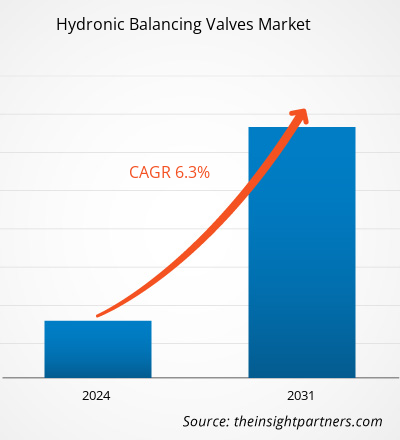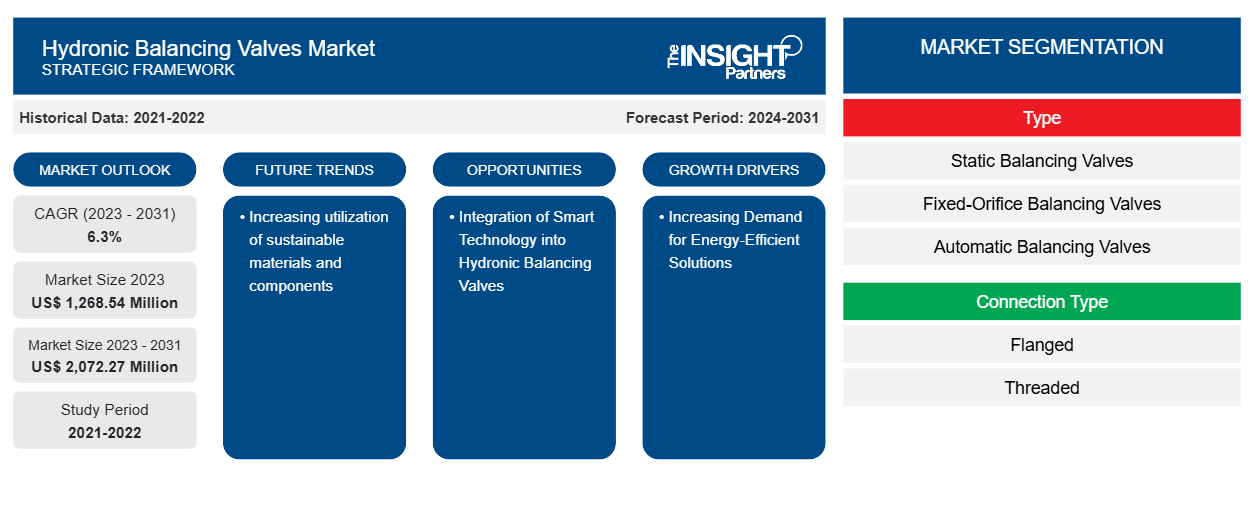ハイドロニックバランスバルブの市場規模は、2023年の12億6,854万米ドルから2031年には20億7,227万米ドルに達すると予測されています。市場は2023年から2031年の間に6.3%のCAGRを記録すると予想されています。インフラ建設における持続可能な材料と部品の利用の増加は、市場の主要なトレンドであり続けると思われます。
ハイドロニックバランスバルブ市場分析
米国などの先進国では人口が急速に増加しており、これが商業スペース数の増加につながっています。2022年12月に米国国勢調査局が発表した都市部の最新リストによると、米国の都市部の人口は2010年から2020年の間に約6.4%増加しました。都市部は都市化により密集しており、平均人口密度は2010年の約2,343人から2020年に約2,553人に増加しています。2020年の国勢調査データによると、米国西部地域は最も都市化が進んでおり、人口の約88.9%が都市部に居住しており、次いで北東部が約84.0%となっています。中西部と南部では都市部に居住する人口の割合が低く、それぞれ約75.8%と約74.3%となっています。さらに、都市生活水準には、適切でよく整備された住宅および商業ビルのインフラストラクチャが必要であり、これが HVAC システムの需要を促進します。したがって、世界中で都市化が進むと、ハイドロニックバランスバルブの適用が促進され、市場の成長が促進されます。
ハイドロニックバランスバルブ市場の概要
バランス バルブは、ハイドロニック システムを通る流体の流れを調節するために使用される絞り装置です。ハイドロニック暖房、換気、空調 ( HVAC ) システムでは、バランス バルブは、現在のシステム状態を考慮して、すべての端末への加熱または冷却水の分配を容易にします。ハイドロニック バランス バルブは、ハイドロニック暖房および冷房システムの最適なパフォーマンス、高い動作効率、および低い動作コストを保証します。 HVAC システム内の流体の流れは、システム内のさまざまな状態に適応するために常に変化します。暖房と冷房のニーズに影響を与える要因には、建物の占有率と太陽熱があります。適切な電力を必要なときに必要な場所に供給するには、適切に設計および構築された HVAC システムが必要です。
ラジエーター、HVACシステム、熱交換器、発電システム、サーバー冷却システム、輻射暖房システムなどのハイドロニックシステムアプリケーションからのハイドロニックバランスバルブの需要の増加が、ハイドロニックバランスバルブ市場を牽引しています。さらに、炭素排出量を最小限に抑えるための世界中のエネルギー効率規制の強化により、ハイドロニックバランスバルブの需要が高まっています。さらに、住宅および商業部門での建設活動の急増により、HVACシステムの需要が高まり、2023年から2031年にかけてハイドロニックバランスバルブ市場の成長が促進されると予測されています。
要件に合わせてレポートをカスタマイズする
このレポートの一部、国レベルの分析、Excelデータパックなど、あらゆるレポートを無料でカスタマイズできます。また、スタートアップや大学向けのお得なオファーや割引もご利用いただけます。
-
このレポートの主要な市場動向を入手してください。この無料サンプルには、市場動向から見積もりや予測に至るまでのデータ分析が含まれます。
ハイドロニックバランスバルブ市場の推進要因と機会
エネルギー効率の高いソリューションに対する需要の増加
近年、消費者の間でエネルギー効率の高い機器への嗜好が高まっています。エネルギー効率は、発電および送電用の新しいインフラへの投資の必要性を低下させることで全体的な電力需要を削減し、長期的なメリットをもたらします。また、ユーティリティ リソース ポートフォリオの多様化にも貢献し、不安定なエネルギー調達支出のリスクに対するバッファーとして機能します。エネルギー効率を達成するために、多くの製造業および商業製造会社は、高効率の HVAC システムを調達しています。効率的な HVAC システムは、従来のシステムよりも少ないエネルギーを使用し、より効率的に動作するため、二酸化炭素排出量が削減されます。ハイドロニック システムでは、バランス バルブによって、冷水または温水がすべてのターミナルに分配されます。エネルギーを達成するための空調およびヒート ポンプでの HVAC (暖房、換気、空調) システムの適用の増加と、公共の建物に対するエネルギー効率基準の導入の増加により、さまざまな産業および商業部門で HVAC システムの需要が高まっています。
スマートテクノロジーをハイドロニックバランスバルブに統合
住宅、商業、産業の各分野では、IoT 対応デバイスの普及が世界中で進んでいます。その結果、ハイドロニックバランスバルブのメーカーは顧客に独自のソリューションを提供し、スマート HVAC システムに統合できるスマートハイドロニックバランスバルブを開発しています。スマートハイドロニックバランスバルブは、リアルタイム監視、データ分析機能、自動バランス調整などのインターネットの機能を活用します。これらのバルブをビル管理システム (BMS) に接続することで、リモート監視が可能になり、エネルギー効率とシステムパフォーマンスが大幅に向上します。スマート HVAC システムは、ワイヤレス技術を活用して近くのスマートデバイスと通信し、室内環境を自動的に調整します。商業環境では、スマート HVAC システムは静かな環境を提供しながらエネルギーを節約するのに役立ちます。
ハイドロニックバランスバルブ市場レポートのセグメンテーション分析
ハイドロニックバランスバルブ市場分析の導出に貢献した主要なセグメントは、タイプ、接続タイプ、サイズ、およびアプリケーションです。
- タイプに基づいて、ハイドロニックバランスバルブ市場は、静的バランスバルブ、固定オリフィスバランスバルブ、自動バランスバルブ、および圧力に依存しない流量制御バルブに分類されます。静的バランスバルブセグメントは、2023年に大きな市場シェアを占めました。
- サイズ別に見ると、市場は5インチ未満、6インチ~10インチ、11インチ~20インチ、20インチ以上に区分されます。2023年には5インチ未満のセグメントが市場を支配しました。
- 接続タイプに基づいて、市場はフランジ、ねじ、その他に分類されます。フランジセグメントは2023年に市場を支配しました。
- 用途別に見ると、市場は住宅、商業、工業に分類されます。2023年には住宅部門がより大きな市場シェアを占めました。
地域別ハイドロニックバランスバルブ市場シェア分析
ハイドロニックバランスバルブ市場レポートの地理的範囲は、主に北米、アジア太平洋、ヨーロッパ、中東およびアフリカ、南米および中米の 5 つの地域に分かれています。
2023年、アジア太平洋地域がハイドロニックバランスバルブ市場を支配しました。アジア太平洋地域のハイドロニックバランスバルブ市場は、中国、インド、日本、オーストラリア、韓国、その他のアジア太平洋地域に分かれています。アジア太平洋地域の市場成長は、主に都市化の進行と人口増加によるもので、スマートインフラの必要性が高まっています。さらに、エネルギー効率の高い暖房および冷房ソリューションの適用を奨励することに重点を置いた政府規制により、アジア太平洋地域でハイドロニックバランスバルブの需要が高まっています。この地域では、都市化の急速な進行により、いくつかの不動産プロジェクトや、数多くの産業、住宅、商業開発分野での官民投資が増加しています。住宅部門におけるHVACサービスのニーズは、主に地域全体の新規設置によって推進されています。建設および開発プロジェクトの増加により、ベトナム、マレーシア、タイ、インドネシア、フィリピン、中国を含む東南アジア諸国でエアコンの設置が増加しており、予測期間中にアジア太平洋地域のハイドロニックバランスバルブ市場を推進すると予想されています。
ハイドロニックバランスバルブ市場の地域別分析
予測期間を通じてハイドロニックバランスバルブ市場に影響を与える地域的な傾向と要因は、Insight Partners のアナリストによって徹底的に説明されています。このセクションでは、北米、ヨーロッパ、アジア太平洋、中東、アフリカ、南米、中米にわたるハイドロニックバランスバルブ市場のセグメントと地域についても説明します。

- ハイドロニックバランシングバルブ市場の地域別データを入手
ハイドロニックバランスバルブ市場レポートの範囲
| レポート属性 | 詳細 |
|---|---|
| 2023年の市場規模 | 12億6,854万米ドル |
| 2031年までの市場規模 | 20億7,227万米ドル |
| 世界のCAGR(2023年~2031年) | 6.3% |
| 履歴データ | 2021-2022 |
| 予測期間 | 2024-2031 |
| 対象セグメント |
タイプ別
|
| 対象地域と国 |
北米
|
| 市場リーダーと主要企業プロフィール |
|
ハイドロニックバランスバルブ市場のプレーヤー密度:ビジネスダイナミクスへの影響を理解する
ハイドロニックバランスバルブ市場は、消費者の嗜好の変化、技術の進歩、製品の利点に対する認識の高まりなどの要因により、エンドユーザーの需要が高まり、急速に成長しています。需要が高まるにつれて、企業は提供を拡大し、消費者のニーズを満たすために革新し、新たなトレンドを活用し、市場の成長をさらに促進しています。
市場プレーヤー密度とは、特定の市場または業界内で活動している企業または会社の分布を指します。これは、特定の市場スペースに、その市場規模または総市場価値に対してどれだけの競合相手 (市場プレーヤー) が存在するかを示します。
ハイドロニックバランスバルブ市場で事業を展開している主要企業は次のとおりです。
- ダンフォスAG
- ヘイズ流体制御
- ヴィクトリック社
- レッドホワイトバルブ株式会社
- オヴェントロップ株式会社
- カレフィ SpA シーメンス
免責事項:上記の企業は、特定の順序でランク付けされていません。

- ハイドロニックバランスバルブ市場のトップキープレーヤーの概要を入手
ハイドロニックバランスバルブ市場のニュースと最近の動向
ハイドロニックバランスバルブ市場は、主要な企業出版物、協会データ、データベースなどの一次調査と二次調査後の定性的および定量的データを収集することによって評価されます。ハイドロニックバランスバルブ市場におけるいくつかの動向を以下に示します。
- CALEFFIグループは、Fratelli Creola Srlの買収完了を発表しました。この会社は、クロムメッキとニッケルメッキを専門とする地元のガルバニック業界で60年以上事業を展開しています。両社は、創設者のフランチェスコ・カレフィとロレンツォ・クイント・クレオラから始まり、マルコ・カレフィとマルコ・クレオラに引き継がれ、相互尊重に基づく長年のパートナーシップを維持しています。(出典:CALEFFIグループ、プレスリリース2023年7月)
- Mantro、ザウアーラントを拠点とする家族経営のOventrop GmbH & Co. KG、デュッセルドルフを拠点とするLEG Immobilien SEは、住宅物件向けの暖房と持続可能性を特徴とするグリーンソリューションを開発する合弁会社seeroを設立しました。seero.Proは、3月のISHで業界横断的な3社によって発表された最初のデジタルソリューションです。Seero.Proは、各ラジエーターの暖房システムの水力バランスを自動的に実行します。需要主導の温度制御によるインテリジェントでスマートな暖房に基づいて、追加の暖房コストを節約します。(出典:Oventrop GmbH & Co. KG、プレスリリース、2023年4月)
ハイドロニックバランスバルブ市場レポートの対象範囲と成果物
「ハイドロニックバランスバルブ市場」の規模と予測(2021〜2031年)レポートでは、以下の分野をカバーする市場の詳細な分析を提供しています。
- 対象範囲に含まれるすべての主要市場セグメントについて、世界、地域、国レベルでの水力バランスバルブ市場規模と予測
- ハイドロニックバランスバルブ市場の動向、および推進要因、制約、主要な機会などの市場動向
- 詳細なPEST/ポーターの5つの力とSWOT分析
- 主要な市場動向、世界および地域の枠組み、主要プレーヤー、規制、最近の市場動向を網羅したハイドロニックバランスバルブ市場分析
- 市場集中、ヒートマップ分析、主要プレーヤー、ハイドロニックバランスバルブ市場の最近の動向を網羅した業界の状況と競争分析
- 詳細な企業プロフィール
- 過去2年間の分析、基準年、CAGRによる予測(7年間)
- PEST分析とSWOT分析
- 市場規模価値/数量 - 世界、地域、国
- 業界と競争環境
- Excel データセット
最新レポート
お客様の声
購入理由
- 情報に基づいた意思決定
- 市場動向の理解
- 競合分析
- 顧客インサイト
- 市場予測
- リスク軽減
- 戦略計画
- 投資の正当性
- 新興市場の特定
- マーケティング戦略の強化
- 業務効率の向上
- 規制動向への対応























 無料サンプルを入手 - ハイドロニックバランスバルブ市場
無料サンプルを入手 - ハイドロニックバランスバルブ市場